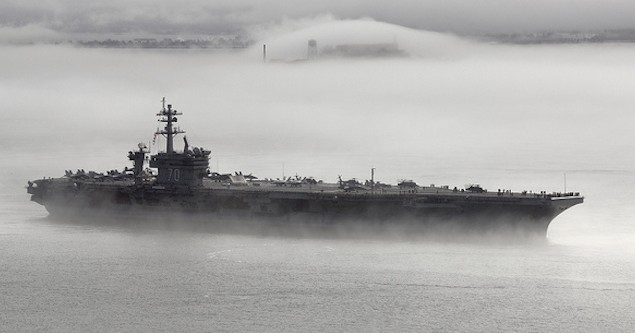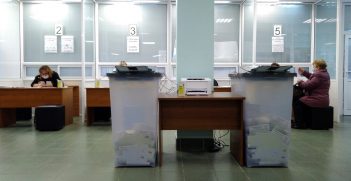Tailhooking in the South China Sea: A Visit to the Supercarrier USS Carl Vinson

Having been deployed to the wars in Afghanistan and Iraq in the past, the USS Carl Vinson, a US navy supercarrier decked in Singapore, is soon headed for the anti-ISIL campaign in the Persian Gulf. Alexander Neill takes us on board.
Stepping onto the deck of the USS Carl Vinson (CVN-70) on 30 September, a group of recently initiated ‘honorary tailhookers’ (an International Institute for Strategic Studies Shangri-La Dialogue Senior Fellow amongst them), emerged from the cabin of the C-2 Greyhound aircraft which had flown them out to the carrier from Singapore’s Paya Lebar airbase. The group, including diplomats and Singapore Armed Forces officers as well as a gaggle of reporters, had just experienced an ‘arrested landing’, whereby the C-2 had hooked a cable across the landing deck and decelerated from 105-0 mph in a little over two seconds.
The visit was conducted at a fortuitous moment for the US navy to demonstrate its commitment to the US rebalance to Asia, despite the irony that the ship is headed for the turmoil in the Middle East. If the US rebalance detractor community is swelling in numbers, then this visit was very much designed to rebuff adherents of the US declinism school of thought in the Asia-Pacific. Whatever the intent, the sheer pace and intensity of the operations we witnessed being conducted on the edge of China’s nine-dash line claim in the South China Sea left us in no doubt that the US is committed to its principles of freedom of passage in the Asia-Pacific region. I reminded myself too that the USS Carl Vinson would have passed quite close to the group of reefs and islets where China is fast-tracking reclamation activities, building habitable islands and apparently an airstrip in the centre of the disputed region.
Masked deck crew wearing bright coloured jerseys ushered us towards the entrance of the ship, ensuring we did not stray into the path of a screaming F-18 Hornet jet fighter landing less than 20 metres away. We had arrived in the midst of a frenetic day of flight operations. After being saluted aboard, the group descended several floors to be greeted by the ship’s commanding officer, Captain Karl Thomas in his quarters. Over light refreshments, we were offered some historical points on the provenance of the ship, her namesake and her battle history before being led into the carrier’s ‘island’ above. Intermittent thuds reverberating around the hull overhead signalled a steady stream of landings on the flight deck.
We were shown the handler’s room; the control room for all flight deck operations. Here, 1950’s technology is still in place as a group of operators issue radio instructions to the crew of the flight deck, moving cut-out shapes of aircraft over a plexiglass scale model of the flight deck, known with dark naval humour as the ‘ouija board’. We then ascended to the admiral’s deck, which offers a panoramic view of the entire flight deck, as a group of four F-18s were corralled into position for catapult-assisted take-off. Donning noise protection, we stepped outside onto ‘vultures alley’, a long viewing deck offering a prime view of the challenges of naval aviation. The F-18s screamed off out over the South China Sea, the catapult tracks steaming as they were re-configured for subsequent launches.
Before long, a group of F-18s and a C-2 circled the carrier at low altitude before landing with the assistance of the arresting cables on the stern. Some of the aircraft missed the cables and roared off the deck again for a second landing attempt. The noise on deck was explosive even with two layers of ear defence. The bravery and expertise of the deck crew is astounding. Young men and women averaging 20 years of age, clad in heavy protective gear in the sweltering heat were demonstrating considerable feats of athleticism in an extremely dangerous and confined space.
The pace and intensity of the operations reflected the impending transition to active military operations as CVN-70 joins the offensive against Islamic State of Iraq and the Levant (ISIL) forces in the Persian Gulf in a few weeks’ time. Her passage through Southeast Asian waters had offered the US navy the opportunity to demonstrate unashamedly its power projection and deterrence capabilities in the South China Sea and to reinforce the US rebalance to Asia narrative. ‘Freedom of navigation’ was a phrase used by US navy officers on several occasions during our tour.
CVN-70 had been on intensive flight operations for five days out of seven in the last few weeks including participation near Guam in exercise Valiant Shield 2014 alongside the USS George Washington battle carrier group, equipped with hundreds of aircraft and nearly 20,000 US personnel. After the exercise, the carrier transited the Philippines via the Surigao Strait and entered the South China Sea, transecting the southernmost portion of China’s nine-dash line territorial claim.
On the navigation deck, it became evident that the US Navy had chosen to perform these exercises on the point where China’s nine-dash line intersects with Indonesian territorial waters. We could see that CVN-70 was moving in a zigzag pattern about 100 km northwest off the northernmost Natuna islands, enabling favourable headwinds for the flight operations on a limpid and calm South China Sea. The only apparent presence of other vessels, causing a degree of concern for the crew, was a cluster of unidentified fishing vessels surrounding CVN-70’s area of operations, visible as ‘popcorn’ markers on the GPS navigation instruments.
After a few days of replenishment and well-earned shore leave for the ship’s crew in Singapore, CVN-70 is now heading across the Indian Ocean towards the Persian Gulf. Catapulting off the deck aboard the C-2 at an eye-popping 0-130 mph in three seconds for our return journey, I was left to ponder the reflections of an officer I spoke with over the prospect of the USS Carl Vinson contributing to the air campaign against ISIL. Despite the fearsome capabilities of the ship, he was convinced that the Islamic State could not be defeated from air alone: boots on the ground were required to win the latest battle in the Middle East.
Alexander Neill is Shangri-La Dialogue Senior Fellow for Asia-Pacific Security in International Institute for Strategic Studies.





